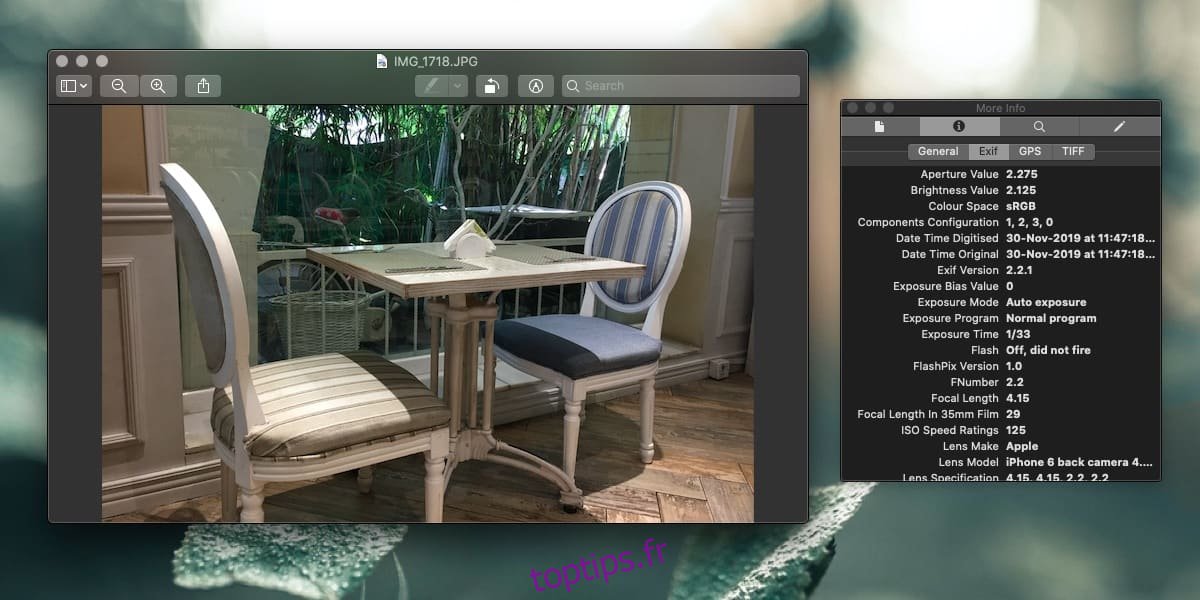

#Exif data mac os windows
I'll go get a book and educate myself on using Terminal.įunny that I am quite competent with the DOS Prompt in Windows and often write complexīatch files but if I thought I could migrate my knowledge intuitively to Terminal, Posted on 10:03:06-07 by dayo in response to 1029 I have tested it personally with raw files from the 7D and A2.
#Exif data mac os plus
Unless there is another directory beginning with the same sequence of characters.Ģ) Yes, you can add EXIF information to any TIFF file (as well as a number of other file types).ģ) You can write all the information you mention, plus a lot more.Ĥ) You can either create this information from scratch, or copy it from another image.ĥ) ExifTool should work on MRW images from any Minolta camera. Press the 'tab' key and the rest of the name will be completed If you know about "tab completion": It is usually not necessary to typeĪn entire directory name - once you have typed a few characters, Hints: The '~' character used above is a short form for your home directory name,

exiftool -previewimage -b ~/Pictures/Minolta.MRW > /Previews/Minolta.jpg Into a directory called "Previews" in the root directory of my boot disk: So for instance, if the image was in my "/Users/phil/Pictures" directory, and assumingĮxiftool is in the current directory, I could type the following to extract the preview You have to either put quotes around the whole name or put a '\' before each space character. This complicates things a bit on the command line because if this happens A complication is that on the Mac it isĬommon to have spaces and sometimes other funny characters in directory and file names. I'll answer your questions as best I can:ġ) You can prefix any filename by the path where it is located.ĭirectory names are separated by '/'. Posted on 00:59:51-07 by exiftool in response to 1028 Sorry for the number of queries and thanks for your assistance. I am a hybrid shooter as in addition to the Dynax 7, I own a Minolta Dynax 7D and a Dimage A2.Īre the raw files from these units supported? I noticed that some other post had something about lenses from the Minolta Dynax 7D. TIFF files that doesn't have one? Perhaps transfer from one image that has then to these ones?ĥ. Is it possible to create these fields in a I have checked and know that the file properties section of my scannedįiles do not have fields for aperture etc. Shot as I used a Minolta Dynax 7 that allows me to output text files with this data.Ĥ. I have scans using a Minolta Scan Dual III and have all the exposure data for each If it is, can I write into the exposure fields such as shutter speed, Aperture etc. The main reason I am interested in this tool is that I want to create Exif dataįor TIFF files from a scanner. In the example you gave (Point 4) was is the step if the file not on the desktop.Ģ. I don't know very much about terminal etc so your response is very welcome.ġ. I am pretty much in the same situation as the original poster in that as a recent Mac adopter, Posted on 23:30:19-07 by dayo in response to 593 (type "printenv PATH" in the terminal window to show your PATH directories).


Instead, you can just copy "exiftool"Īnd the "lib" directory to anywhere in your PATH Note that some MacOS systems don't have the required Perl header files to do The exiftool directory on the command line. README file to do a standard installation. If you want, you can follow the instructions in the (or use Canon.CR2 if the file was CR2 format) Image-ExifTool-5.25/exiftool -TagsFromFile Canon.CRW Canon_JFR.jpg RAW file to the extracted JPEG, type the following: This is the JPEG extracted from the CRW or CR2 file.ĥ) If you want to transfer the EXIF information from the original You should now have a file called "Canon_JFR.JPG" on your desktop. Image-ExifTool-5.25/exiftool -PreviewImage -b Canon.CR2 > Canon_JFR.JPG CR2 format RAW files, you need to extract the PreviewImage instead: Image-ExifTool-5.25/exiftool -JpgFromRaw -b Canon.CRW > Canon_JFR.JPG Type the following to extract the JPEG image: (Note: Replace "5.25" with the version number you actually downloaded.)Ĥ) Assuming your Canon RAW file is on the desktop and named "Canon.CRW",
#Exif data mac os download
Safari), download the latest version of exiftoolĢ) Open a terminal window (by running "Terminal" from the /Applications/Utilities folder).ģ) In the terminal window, type the following: Posted on 13:03:40-07 by exiftool in response to 592ġ) Using your favourite browser (ie. I would appreciate tutoringĪs my real work is photography and not computer programming. I have tried to follow the directions but I have been unsuccessful and it's getting Is extracting JPEGs from CANON RAW image files. I am really only interested in one feature at the moment and that With Apple's Terminal and Perl and ExifTool all at the same time. Is there information for beginners like myself who are trying to get started


 0 kommentar(er)
0 kommentar(er)
